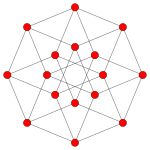

| 7-cube Hepteract | |
|---|---|
 Orthogonal projection inside Petrie polygon The central orange vertex is doubled | |
| Type | Regular 7-polytope |
| Family | hypercube |
| Schläfli symbol | {4,35} |
| Coxeter-Dynkin diagrams |
|
| 6-faces | 14{4,34} |
| 5-faces | 84{4,33} |
| 4-faces | 280 {4,3,3} |
| Cells | 560 {4,3} |
| Faces | 672 {4} |
| Edges | 448 |
| Vertices | 128 |
| Vertex figure | 6-simplex |
| Petrie polygon | tetradecagon |
| Coxeter group | C7, [35,4] |
| Dual | 7-orthoplex |
| Properties | convex, Hanner polytope |
Ingeometry, a 7-cube is a seven-dimensional hypercube with 128 vertices, 448 edges, 672 square faces, 560 cubic cells, 280 tesseract 4-faces, 84 penteract 5-faces, and 14 hexeract 6-faces.
It can be named by its Schläfli symbol {4,35}, being composed of 3 6-cubes around each 5-face. It can be called a hepteract, a portmanteauoftesseract (the 4-cube) and hepta for seven (dimensions) in Greek. It can also be called a regular tetradeca-7-topeortetradecaexon, being a 7 dimensional polytope constructed from 14 regular facets.
The 7-cube is 7th in a series of hypercube:

|

|

|

|

|

|

|

|
| Line segment | Square | Cube | 4-cube | 5-cube | 6-cube | 7-cube | 8-cube |
The dual of a 7-cube is called a 7-orthoplex, and is a part of the infinite family of cross-polytopes.
Applying an alternation operation, deleting alternating vertices of the hepteract, creates another uniform polytope, called a demihepteract, (part of an infinite family called demihypercubes), which has 14 demihexeractic and 64 6-simplex 6-faces.
This configuration matrix represents the 7-cube. The rows and columns correspond to vertices, edges, faces, cells, 4-faces, 5-faces and 6-faces. The diagonal numbers say how many of each element occur in the whole 7-cube. The nondiagonal numbers say how many of the column's element occur in or at the row's element.[1][2]

Cartesian coordinates for the vertices of a hepteract centered at the origin and edge length 2 are
while the interior of the same consists of all points (x0, x1, x2, x3, x4, x5, x6) with -1 <xi < 1.
 This hypercube graph is an orthogonal projection. This orientation shows columns of vertices positioned a vertex-edge-vertex distance from one vertex on the left to one vertex on the right, and edges attaching adjacent columns of vertices. The number of vertices in each column represents rows in Pascal's triangle, being 1:7:21:35:35:21:7:1. |
| Coxeter plane | B7 / A6 | B6 / D7 | B5 / D6 / A4 |
|---|---|---|---|
| Graph | 
|

|

|
| Dihedral symmetry | [14] | [12] | [10] |
| Coxeter plane | B4 / D5 | B3 / D4 / A2 | B2 / D3 |
| Graph | 
|

|

|
| Dihedral symmetry | [8] | [6] | [4] |
| Coxeter plane | A5 | A3 | |
| Graph | 
|

| |
| Dihedral symmetry | [6] | [4] |
|
Fundamental convex regular and uniform polytopes in dimensions 2–10
| ||||||||||||
|---|---|---|---|---|---|---|---|---|---|---|---|---|
| Family | An | Bn | I2(p) / Dn | E6 / E7 / E8 / F4 / G2 | Hn | |||||||
| Regular polygon | Triangle | Square | p-gon | Hexagon | Pentagon | |||||||
| Uniform polyhedron | Tetrahedron | Octahedron • Cube | Demicube | Dodecahedron • Icosahedron | ||||||||
| Uniform polychoron | Pentachoron | 16-cell • Tesseract | Demitesseract | 24-cell | 120-cell • 600-cell | |||||||
| Uniform 5-polytope | 5-simplex | 5-orthoplex • 5-cube | 5-demicube | |||||||||
| Uniform 6-polytope | 6-simplex | 6-orthoplex • 6-cube | 6-demicube | 122 • 221 | ||||||||
| Uniform 7-polytope | 7-simplex | 7-orthoplex • 7-cube | 7-demicube | 132 • 231 • 321 | ||||||||
| Uniform 8-polytope | 8-simplex | 8-orthoplex • 8-cube | 8-demicube | 142 • 241 • 421 | ||||||||
| Uniform 9-polytope | 9-simplex | 9-orthoplex • 9-cube | 9-demicube | |||||||||
| Uniform 10-polytope | 10-simplex | 10-orthoplex • 10-cube | 10-demicube | |||||||||
| Uniform n-polytope | n-simplex | n-orthoplex • n-cube | n-demicube | 1k2 • 2k1 • k21 | n-pentagonal polytope | |||||||
| Topics: Polytope families • Regular polytope • List of regular polytopes and compounds | ||||||||||||